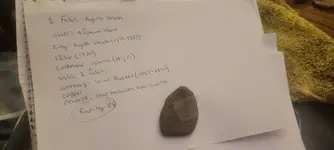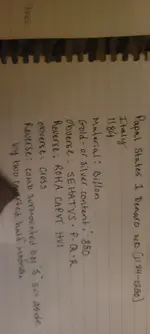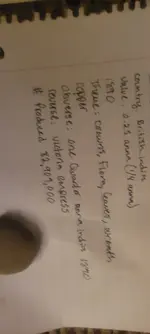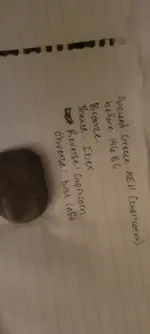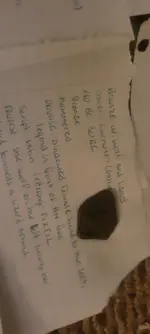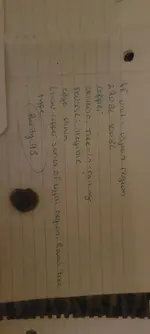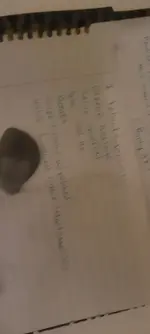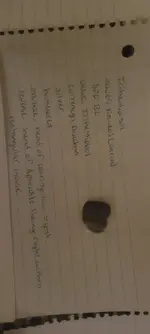Re: Susquehanna County, Pennsylvania Treasure.
Greetings Jeff, Cannonman17 and everyone,
Thanks again for the kind words Jeff, really made my day. I must add that I enjoy your posts too!
I would suggest that if you were going to hunt the Susquehanna, I would look for the natural fords,
where a visiting boat might have to put ashore and perhaps do some trading. The coins and relics are
apt to be deep, but the way river erosion and soil deposition is erratic they may be shallow too.
I can't say that Carthage hid their treasury in the Susquehanna basin, but it IS possible - the Romans
went so far as to send out expeditions into the Sahara desert and even a squadron of ships out to the
Punic colonies along the Atlantic coast of Africa (under the command of the Greek historian Polybius, no less)
and they failed to find it. What better place could they have chosen to hide their treasure from the
Roman enemy but in a land that only they knew about?
Most of the Carthaginian coins found have been singles, though in one case in Alabama, two were found
in the same area along a river. Most of the finds have been along rivers and beaches, though there have been
several finds of caches too that were a ways from a navigable river or stream, such as the stash of Punic gold
coins found in a cave in eastern Tennessee, or several stashes found in Georgia. To try to cover at least
some of the evidence or proof that Carthaginians and their Phoenician fore-fathers were visiting the Americas,
I must ask your patience and forebearance, as this will make for a very lengthy post!
Now as to what proof is there to support this idea? I have already referred to the coins - though modern historians dismiss them as ALL having been dropped in MODERN times, as if lots of people walked around with relatively rare and valuable coins of ancient Carthage in their pockets. If they were referring to Roman bronze
coins, I could agree - they can be bought very cheaply in the un-cleaned state for $1 each or even less,
and are even frequently given to schoolchildren as learning aids or as a keepsake. However we are talking
about coins that are NOT common and certainly not cheap - some of the silver tetradrachms of Carthage found
are sold in the $1500 each range, with the gold coins we are talking thousands of dollars. Gloria Farley
includes a chapter on the coincidence of the coins, it includes several of the Punic coins and some Romans as
well, from her book In Plain Sight, Old World Records in Ancient America, it is online at:
http://phoenicia.org/brazil.html
Then we have the ancient writers. We have almost nothing from the Carthaginians themselves, as the Romans were very thorough in their destruction of their rival, so most of the evidence must come from sources which were in truth enemies of Carthage and had very imperfect understandings of the discoveries made by them. Even so, check out Aristotle's work On Marvelous Things Heard, describes how the Carthaginians discovered what can only be America by accident, and even attempted to found a colony there but later withdrew it by order of the Carthaginian senate; he explained that the senate felt that too many people would move there due to the excellence of the place, and it would be best kept as a safe haven that their people could flee to if some calamity should overtake their homeland; in the event such a disaster DID overtake the city when the Romans destroyed it, but they were unable to escape as the Romans under Scipio had closed off their port entrance with a mole. Don't expect to find this text of Aristotle online though, it is one of those that will not "fit" with the accepted theories!
Then there is the Sicilian Greek historian Diodorus Siculus; his massive work titled Library of History has a much
greater description of the secret land of the Carthaginians and explains how they found it by accident when some
merchant ships sailing down the Atlantic coast of Africa were blown across the ocean to the west. Most of the
description is found in books 2 and 3, which are NOt online anywhere, again this will not fit with the accepted Isolationist theory. And yes, the Isolation idea is still a theory.
Plato includes a remarkable passage in his work Timaeus, which the Atlantis-hunters so frequently overlook it is
amazing - here it is"Many great and wonderful deeds are recorded of your state in our histories. But one of them exceeds all the rest in greatness and valour. For these histories tell of a mighty power which unprovoked made an expedition against the whole of Europe and Asia, and to which your city put an end. This power came forth out of the Atlantic Ocean, for in those days the Atlantic was navigable; and there was an island situated in front of the straits which are by you called the Pillars of Heracles; the island was larger than Libya and Asia put together, and was the way to other islands, and from these you might pass to the whole of the opposite continent which surrounded the true ocean; for this sea which is within the Straits of Heracles is only a harbour, having a narrow entrance, but that other is a real sea, and the surrounding land may be most truly called a boundless continent. "
Note that Plato describes a vast continent on the other side of the Atlantic, and that this is a true continent - and is exactly what the Americas would seem to be to a ship exploring the coast! The Atlantis-hunters mis-read this to interpret that Atlantis was a continent, which is not what Plato said, he said that was a group of islands, but no matter - Plato has just proven that the ancient WERE aware of the Americas! In fact, the name they called it was "Ogygia".
Plutarch describes the northern route to the Americas used by the Carthaginians too, the same route taken by the Norse many centuries later; it is found in his book Moralia XII, On The Face Of The Moon, and describes the finding of an ancient scroll in the ruins (then) of Carthage including sailing directions to America. Plutarch mentions that some "greeks" had intermarried there and settled there, but the Greeks tended to call anyone they considered civilized as "greek" and thus claim some honors; anyway he also states that a native of this faraway land even sailed across to now-ruined Carthage and remained there a long time, perhaps mourning the loss of their good trading allies.
There are a number of other ancient sources including the fragments of the periplus of Himilco, which states that it takes four months to cross the Atlantic ocean by the northern route - but does not say what is on the other side; however cross to what else BUT America? Aelian has a surprising description of America in his Natural History too, which is clearly somewhat garbled but includes a description of what might well be the Grand Canyon!
With all these ancient sources, I ought to include the mysterious "map on a coin" discovered by professor Mark McMenamin;
he took a great deal of flak over announcing his discovery that on some ancient Punic gold coins, there is what appears to be a map showing parts of the Americas as well as Europe and Africa on the reverse under the famous "horse of Carthage". Ancient coin experts dismiss this as the result of brockage or debris on the dies used to strike the coins, and point to other coins which have blobs on them to prove this - however these other blobs look like blobs, while the map looks very much like a map. It is online and you can judge for yourself at:
http://phoenicia.org/america.html
This site also has an article of my own on this theory (not the map) at:
http://phoenicia.org/carthanewworld.html
The point has been raised in objection to the map on a coin that if the Carthaginians knew of the Americas and were keeping it a secret, why would they depict it on a map on their coins? The answer seems obvious, that the coin makers put the map on the coins and when this was discovered, they were ordered to remove it, and to support this, the maps only appear on a short series of coins and is never repeated afterward.
Then there are the inscriptions left behind. At the site known as Mystery Hill in New Hampshire, not far from Boston Mass, when excavated they discovered an inscription in Punic, dedicating the site to their god Baal. Also in the same area outside Boston, one of the stone steles claiming the lands for Carthage in the name of admiral Hanno was found. Off shore on Block Island is yet another Punic inscription, which states the site is a loading area for their ships! Other stone steles claiming the lands in the name of Hanno have been found in the eastern areas of the Americas including one found near Hawley PA (I made some efforts to locate this stone, but it has apparently been removed.) and even in such far-flung places as Nevada we find a Punic inscription on the shore of a now-dry lake, giving sailing directions! There is also the Pontotoc stone, found in Iowa, which also has Punic religious prayers, the finds of arrowheads in the mid-west with Punic or Phoenician letters on them, and on the other side of the 'big pond' a wooden table was discovered in an ancient Phoenician tomb in what is today Lebanon, which was constructed of the super-hard Brazilian wood known locally as "Pau" or "axe-breaker"! We have already touched on the strange finding of American tobacco (even aa actual tobacco leaf found in the wrappings) of Egyptian mummies, and that they had used American coca in their lifetimes - which is more likely, that Egyptians, who rarely ever sailed beyond the Nile, or the Punic and Phoenicians sailors who were known (and this much admitted even by the skeptical historians) to be bringing ebony and ivory from south Africa, cloves from the Moluccas in extreme SE Asia, cinnamon and other spices from faraway China and India as well as tin and amber from the British Isles and Baltic? There are also the strange stone near Los Lunas, New Mexico which some people believe to be an ancient inscription of the Ten commandments, but can also be read (and better fit, I might add) in Phoenician and describes their visit to this faraway land; a number of stone inscriptions found in Brazil are worthy of note too, you can read about them online at:
http://phoenicia.org/brazil.html
One stone, the Paraiba stone, describes how a Phoenician ship in the time of king Hiram (friend and ally of wise king Solomon) became lost in a storm and ended up stranded in what is today Brazil! This fits pretty closely with what Aristotle and Diodorus said is how the Phoenicians and their offspring the Carthaginians discovered America too!
A side note is in order here - it seems that the Punic name for what is today called Brazil was "Bar-Zil" which means "land of iron" - it is remarkably close to the name Brazil! By comparison, their name for Britain was Bar-itanni, which meant "land of tin" for they traded for the important tin there, required for the production of bronze. Speaking of place-names, there is even a US state with a Punic name! Alaska, which is said in the native tongue to mean "the great land" is remarkably close to the Punic Al-Asqa, which means very much the same thing! Another coincidence?
Then there are the products which "somehow" end up on both sides of the oceans - like cotton for instance. Cotton
originated in the Old World, and yes there is an American type of cotton which is genetically different from Old
World cotton, but we find that Old World cotton was being cultivated by Aztecs, Mayans and Incas when first discovered by Europeans. In fact, on Columbus's very first voyage, on his very first encounter with natives of the Americas, he reports that he was offered spools of cotton as a trade item! How did Americans get Old World cotton before Columbus? Birds?
We have the in-explicable presence of Asiatic chickens found over vast areas of both North and South America when first visited by Europeans. Gavin Menzies claims these are proof of the single visit of Chinese in the year 1421, yet is this logical, that chickens would have spread across the length and breadth of two continents in the span of just 71 years before Columbus arrived? (I am currently reading his book 1421, and have many, many bones to pick with Gavin on his theories.) Well according to historians, chickens were introduced to the west by Alexander the Great when he returned from India, around 322 BC. However then how do we explain the Punic coins struck in one of their cities in Sicily around 480 BC, which clearly depict what can ONLY be a chicken, specifically a rooster? It seems that the Carthaginians were in fact introducing chickens a couple of centuries before Alexander brought some back from India, and dating to a time period very close to that of admiral Hanno! We know that the Carthaginians even had their own special trading marts in India, which is where chickens originated so...it is not a great leap of logic to come to the conclusion that they brought chickens as useful fowl to trade in their new-found markets.
Then there is the case of the "missing" copper in the upper Great Lakes region. There were many ancient mines active in the region and the amount of copper "missing" (un-accountable in the Americas) amounts to BILLIONS of pounds! Conversely, we have the ancient civilizations found around the Mediterranean basin, which used up billions of pounds of bronze (which is some 98 percent copper more or less) yet there are not enough known sources in their "world" to account for it! Is this another "coincidence"? Is it coincidental that when the first Europeans arrived in the Americas, they found that the natives valued copper over gold; consider what a Carthaginian merchant might do to trade with a primitive people, in order to get "worthless" gold from them in return for "valuable" copper! And the Carthaginians were nothing if not shrewd merchants.
I could go on here with this list of commodities that "somehow" made it across the oceans in ancient times, which
coincidentally happen to be the same periods when Carthage and the Phoenicians were at their most powerful zenith. Here are a few you can research on your own:
- Bananas, which are difficult to propogate and cannot survive being transported through cold regions.
- Hemp, a MAJOR item of trade with Carthaginians and Phoenicians as well, found in use by many American cultures
- Sweet potatoes, an American plant, found being cultivated in West Africa, coincidentally the same areas ruled by Carthage
- Maize, found growing in the Philippines
- Corn, the American type, found in ancient India and west Africa, again areas known to have been frequented by Punic merchants
- Peanuts, an American plant, found in an ancient Chinese tomb, coincidentally an area where spices were traded in ancient times
- Bottle gourds, another American plant, found in west Africa, again in the same regions where Carthage ruled
There are more including several types of peppers, but you begin to see the tracks! We have not touched on the
strange coincidence of building pyramids in the Americas. Hmm, the "experts" say this is all coincidence, and
point to the fact that we can show how the Egyptians developed pyramids, beginning with a stone bench known as "moustaba" then stacking them to form a stepped pyramid, finally the true pyramid - well then why is it NOT
possible to show the same progression anywhere in the Americas, they just start building them? Again, we know
that most American pyramids are of the truncated (flat-topped) and step-sided type, well is it another coincidence that we find Carthaginian pyramids in Sardinia and the Canary Islands are truncated and stepped? In fact a truncated pyramid is a part of the symbol of the most important goddess of the Carthaginians, Tanit!
Then there are the "coincidental" practices found in the Americas too like the horrific practice of child and human
sacrifice, found common among Amerindian cultures including Aztecs, Mayans, and Incas, well the Phoenicians and Carthaginians were also infamous for human sacrifice. The wearing of an earring was the mark of a slave among Carthaginians, this was also true among many tribes in the eastern Americas - another coincidence? Many Amerindian tribes used a form of communication known as "smoke signals" to communicate over long distances - this was a Carthaginian practice as well! Another coincidence? Just how many "coincidences" are we supposed to swallow? Many Amerindian tribes would cook and eat their dogs when times were hard - well should we then be surprised to learn that the Carthaginians did the exact same thing?
Indian seer tradition holds that in ancient times, great ships with white sails would come from Britain, Spain and
North Africa to trade in America which they called Turtle Island, obtaining gold here; they had a rule however that
none of the visitors were allowed to remain on the "island" over a winter, the penalty being death! This is
the exact same penalty described by Aristotle for anyone who went to the secret land of Carthage to live, after
the official colony was withdrawn! Spain was ruled by Carthage, and there were Punic colonies in Britain and Ireland for many centuries too! Another "coincidence"?
Does this mean that there were huge fleets of Carthaginian ships traversing the oceans on a daily basis? No, there WAS some level of contact taking place, but it was sporadic and always on a small scale - though Aristotle felt that Carthage owed her wealth to her secret land, the number of ships visiting was probably not even one per year. I have been attacked by skeptics who say that if I claim Carthaginians were visiting America, then it is like saying there were Roman legions marching around in Illinois and the Carthaginians had a secret Moon base! Well there is some evidence that one or more Roman ships may have accidentally reached America, as the mysterious wreck off the beach near Beverly Mass has been disgorging Roman coins onto the shore for many years now. However the presence of Carthaginian ship wrecks is not well known - these include what can only be a Punic ship in the Bay of Jars, Brazil, another found "deeply embedded in sand" in Mexico in the 19th century (this one a warship), another described as "Roman" on the coast of Texas but more likely Punic, one found off the coast of Honduras relatively recently which had some amphorae and anchors recovered which are now in a museum there, and a Phoenician shipwreck which is older (around 1100 BC) found off the coast of Bimini Island by divers looking at the so-called "Bimini Road" and seeking Atlantis. This last wreck was examined by Yale professor J. Manson Valentine and was mentioned on TV in the old series with Leonard Nimoy as host, In Search Of, some years back.
So how much "proof" do we need? We actually have more proof that Carthaginians and Phoenicians were visiting America than we have of many known and accepted explorers,including Columbus! We are only scratching the surface here, I could bore you to death with many more pages of evidence but I fear I may have already tried your patience over-much. I apologize for such a lengthy post here but wanted to at least try to cover some of the interesting points - believe it or not there are
many more! If you care to read more on this type of theory, I would suggest America BC and Saga America by the late Dr. Barry Fell (he has been widely attacked for his errors in translating many inscriptions, for instance using an Arabic dictionary to try to read Punic, when he would have been better served to use a Hebrew dictionary which is a much more closely related language) the book mentioned above by Gloria Farley which includes many illustrations of inscriptions she discovered in the midwest, (In Plain Sight, Old World Records in Ancient America) and if you like far-out theories the book Underground, the Disinformation Guide to Ancient Civilizations &c edited by Preston Peet, my own contribution to this work is titled The Secret Land and covers much of what I have already said here but also includes articles by famous authors including Erik von Daniken, Andrew Collins, Robert Shoch, Graham Hancock and many
more. The book I have been working on for close to seven years now is nearing completion and I would be happy to let you know when it is released, it includes chapters not only on Carthaginian visitors but also Hebrews, Egyptians, Celts, Norse, Welsh, Irish, Scots and Chinese in ancient times. America truly is a "melting pot" and source of refuge, and apparently ALWAYS has been!
Thank you for your time, shouldn't have gotten me started on this as I always get carried away! I hope you guys have a great day, you certainly made mine.

your friend,
Oroblanco - Roy A. Decker
"I have seen, in my lifetime, many an old fool; but this one tops them all!" --Hannibal Barca


